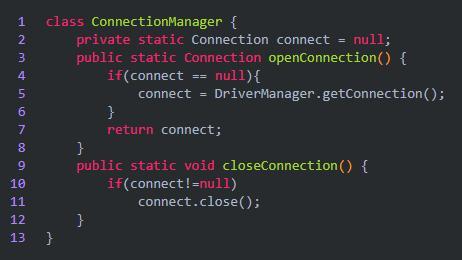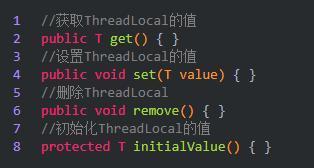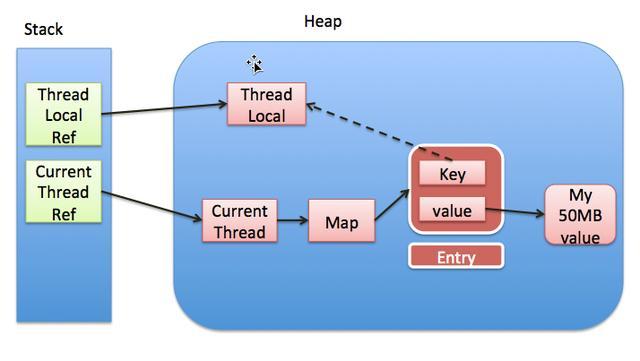在java的多线程模块中,ThreadLocal是经常被提问到的一个知识点,提问的方式有很多种,可能是循序渐进也可能是就像我的题目那样,因此只有理解透彻了,不管怎么问,都能游刃有余。
这篇文章主要从以下几个角度来分析理解
1、ThreadLocal是什么
2、ThreadLocal怎么用
3、ThreadLocal源码分析
4、ThreadLocal内存泄漏问题
下面我们带着这些问题,一点一点揭开ThreadLocal的面纱。若有不正之处请多多谅解,并欢迎批评指正。以下源码均基于jdk1.8。
一、ThreadLocal是什么
从名字我们就可以看到ThreadLocal叫做线程变量,意思是ThreadLocal中填充的变量属于当前线程,该变量对其他线程而言是隔离的。ThreadLocal为变量在每个线程中都创建了一个副本,那么每个线程可以访问自己内部的副本变量。
从字面意思来看非常容易理解,但是从实际使用的角度来看,就没那么容易了,作为一个面试常问的点,使用场景那也是相当的丰富:
1、在进行对象跨层传递的时候,使用ThreadLocal可以避免多次传递,打破层次间的约束。
2、线程间数据隔离
3、进行事务操作,用于存储线程事务信息。
4、数据库连接,Session会话管理。
现在相信你已经对ThreadLocal有一个大致的认识了,下面我们看看如何用?
/** * ThreadLocalMap is a customized hash map suitable only for * maintaining thread local values. No operations are exported * outside of the ThreadLocal class. The class is package private to * allow declaration of fields in class Thread. To help deal with * very large and long-lived usages, the hash table entries use * WeakReferences for keys. However, since reference queues are not * used, stale entries are guaranteed to be removed only when * the table starts running out of space. */ static class ThreadLocalMap { /** * The entries in this hash map extend WeakReference, using * its main ref field as the key (which is always a * ThreadLocal object). Note that null keys (i.e. entry.get() * == null) mean that the key is no longer referenced, so the * entry can be expunged from table. Such entries are referred to * as "stale entries" in the code that follows. */ static class Entry extends WeakReference<ThreadLocal<?>> { /** The value associated with this ThreadLocal. */ Object value; Entry(ThreadLocal<?> k, Object v) { super(k); value = v; } } }
二、ThreadLocal怎么用
既然ThreadLocal的作用是每一个线程创建一个副本,我们使用一个例子来验证一下:

从结果我们可以看到,每一个线程都有各自的local值,我们设置了一个休眠时间,就是为了另外一个线程也能够及时的读取当前的local值。
这就是TheadLocal的基本使用,是不是非常的简单。那么为什么会在数据库连接的时候使用的比较多呢?

上面是一个数据库连接的管理类,我们使用数据库的时候首先就是建立数据库连接,然后用完了之后关闭就好了,这样做有一个很严重的问题,如果有1个客户端频繁的使用数据库,那么就需要建立多次链接和关闭,我们的服务器可能会吃不消,怎么办呢?如果有一万个客户端,那么服务器压力更大。
这时候最好ThreadLocal,因为ThreadLocal在每个线程中对连接会创建一个副本,且在线程内部任何地方都可以使用,线程之间互不影响,这样一来就不存在线程安全问题,也不会严重影响程序执行性能。是不是很好用。
以上主要是讲解了一个基本的案例,然后还分析了为什么在数据库连接的时候会使用ThreadLocal。下面我们从源码的角度来分析一下,ThreadLocal的工作原理。
三、ThreadLocal源码分析
在最开始的例子中,只给出了两个方法也就是get和set方法,其实还有几个需要我们注意。

方法这么多,我们主要来看set,然后就能认识到整体的ThreadLocal了:
1、set方法
/** * Sets the current thread's copy of this thread-local variable * to the specified value. Most subclasses will have no need to * override this method, relying solely on the {@link #initialValue} * method to set the values of thread-locals. * * @param value the value to be stored in the current thread's copy of * this thread-local. */ public void set(T value) { Thread t = Thread.currentThread(); ThreadLocalMap map = getMap(t); if (map != null) map.set(this, value); else createMap(t, value); }
从set方法我们可以看到,首先获取到了当前线程t,然后调用getMap获取ThreadLocalMap,如果map存在,则将当前线程对象t作为key,要存储的对象作为value存到map里面去。如果该Map不存在,则初始化一个。
OK,到这一步了,相信你会有几个疑惑了,ThreadLocalMap是什么,getMap方法又是如何实现的。带着这些问题,继续往下看。先来看ThreadLocalMap。
我们可以看到ThreadLocalMap其实就是ThreadLocal的一个静态内部类,里面定义了一个Entry来保存数据,而且还是继承的弱引用。在Entry内部使用ThreadLocal作为key,使用我们设置的value作为value。
还有一个getMap
/** * Get the map associated with a ThreadLocal. Overridden in * InheritableThreadLocal. * * @param t the current thread * @return the map */ ThreadLocalMap getMap(Thread t) { return t.threadLocals; }
调用当期线程t,返回当前线程t中的成员变量threadLocals。而threadLocals其实就是ThreadLocalMap。
2、get方法
/** * Returns the value in the current thread's copy of this * thread-local variable. If the variable has no value for the * current thread, it is first initialized to the value returned * by an invocation of the {@link #initialValue} method. * * @return the current thread's value of this thread-local */ public T get() { Thread t = Thread.currentThread(); ThreadLocalMap map = getMap(t); if (map != null) { ThreadLocalMap.Entry e = map.getEntry(this); if (e != null) { @SuppressWarnings("unchecked") T result = (T)e.value; return result; } } return setInitialValue(); }
通过上面ThreadLocal的介绍相信你对这个方法能够很好的理解了,首先获取当前线程,然后调用getMap方法获取一个ThreadLocalMap,如果map不为null,那就使用当前线程作为ThreadLocalMap的Entry的键,然后值就作为相应的的值,如果没有那就设置一个初始值。
如何设置一个初始值呢?
原理很简单
3、remove方法
/** * Removes the current thread's value for this thread-local * variable. If this thread-local variable is subsequently * {@linkplain #get read} by the current thread, its value will be * reinitialized by invoking its {@link #initialValue} method, * unless its value is {@linkplain #set set} by the current thread * in the interim. This may result in multiple invocations of the * {@code initialValue} method in the current thread. * * @since 1.5 */ public void remove() { ThreadLocalMap m = getMap(Thread.currentThread()); if (m != null) m.remove(this); }
从我们的map移除即可。
OK,其实内部源码很简单,现在我们总结一波
(1)每个Thread维护着一个ThreadLocalMap的引用
(2)ThreadLocalMap是ThreadLocal的内部类,用Entry来进行存储
(3)ThreadLocal创建的副本是存储在自己的threadLocals中的,也就是自己的ThreadLocalMap。
(4)ThreadLocalMap的键值为ThreadLocal对象,而且可以有多个threadLocal变量,因此保存在map中
(5)在进行get之前,必须先set,否则会报空指针异常,当然也可以初始化一个,但是必须重写initialValue()方法。
(6)ThreadLocal本身并不存储值,它只是作为一个key来让线程从ThreadLocalMap获取value。
OK,现在从源码的角度上不知道你能理解不,对于ThreadLocal来说关键就是内部的ThreadLocalMap。
四、ThreadLocal其他几个注意的点
只要是介绍ThreadLocal的文章都会帮大家认识一个点,那就是内存泄漏问题。我们先来看下面这张图。

上面这张图详细的揭示了ThreadLocal和Thread以及ThreadLocalMap三者的关系。
1、Thread中有一个map,就是ThreadLocalMap
2、ThreadLocalMap的key是ThreadLocal,值是我们自己设定的。
3、ThreadLocal是一个弱引用,当为null时,会被当成垃圾回收
4、重点来了,突然我们ThreadLocal是null了,也就是要被垃圾回收器回收了,但是此时我们的ThreadLocalMap生命周期和Thread的一样,它不会回收,这时候就出现了一个现象。那就是ThreadLocalMap的key没了,但是value还在,这就造成了内存泄漏。
解决办法:使用完ThreadLocal后,执行remove操作,避免出现内存溢出情况。
0 条评论